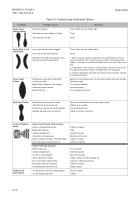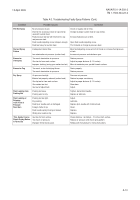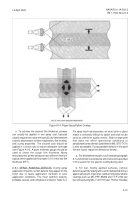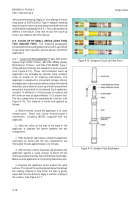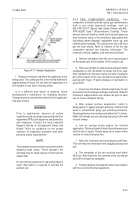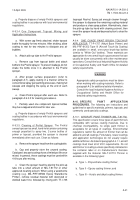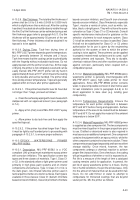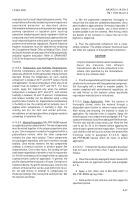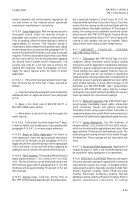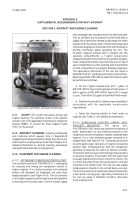TM-1-1500-344-23-2 - Page 192 of 240
A-22
NAVAIR 01-1A-509-2
TM 1-1500-344-23-2
15 April 2009
A-10.2. EPOXY
HIGH
SOLIDS
PRIMER
(MIL-PRF-23377).
A-10.2.1. Description. MIL-PRF-23377 is a VOC
compliant (340 g/l maximum) epoxy high solids primer
with corrosion inhibitors. This specification covers two
types and three classes of materials. Type I, Class C1
or C2, is the standard yellow or light green primer used
primarily in high gloss paint systems and on interior
components and surfaces. Type II, Class C1 or C2, is
the dark green low infrared reflective primer used in
tactical paint schemes on exterior surfaces. Each type
is available in three classes: Class C1 (barium chromate
based corrosion inhibitor), Class C2 (strontium chromate
based corrosion inhibitor), and Class N (non-chromate
based corrosion inhibitor). Class N materials, especially
Type I, may be a variety of colors, such as white, tan,
blue, black, or bright green. They will not have the same
coloration as Type I, Class C1 or C2 materials. Consult
specific maintenance instructions for guidance on the
selection of primers for each weapons system. Class
C1 shall be selected when no class is specified. Class
N shall not be substituted for Class C1 or C2 unless
authorization for its use is given by the engineering
authority for the system or item to which the primer
coating is to be applied. These primers can be applied
to properly treated metal surfaces and to cured, scuff
sanded primers and topcoats. They dry to durable,
chemical resistant films and offer excellent protection
against corrosion, particularly when coupled with a
compatible topcoat.
A-10.2.2. Temperature Requirements. Ensure the
temperature for each primer component is between
60
°
F and 90
°
F before mixing and application. Surface
temperature of the area to be coated must be between
50
°
F and 95
°
F. Do not apply this material if the ambient
temperature is below 50
°
F.
A-10.2.3. Material Preparation. MIL-PRF-23377 primer
is supplied as a two component kit. The two components
must be mixed together in the proper proportions prior
to use. One component contains the pigment within an
epoxy vehicle, while the other component contains the
resin solution. These components are packaged
separately and have excellent storage stability. Once
mixed, however, the two components undergo a
chemical reaction to achieve proper film characteristics.
Over a few hours, the coating will gel and harden
regardless of whether or not it is exposed to air. Pot life
is a measure of the length of time a catalyzed coating
remains useful for application. In general, the pot life of
epoxy primer is 4 hours. During hot or humid conditions,
the pot life will decrease. Only mix the amount of
material that can be used within two hours. Do not add
thinner to attempt to compensate for thickened coatings
that are beyond useful pot life. Mix the primer as follows:
a. Mix the pigmented component thoroughly to
ensure that the solids are completely dispersed. Use a
paint shaker for approximately 10 minutes if possible. If
a paint shaker is not available, use a clean metal or
wooden paddle to stir the contents. After mixing, check
the bottom of the container to ensure that all of the
pigment is dispersed.
b. Pour the pigmented component into a clean,
empty container. The empty container must be at least
two times the capacity of the pigmented component.
CAUTION
Only mix materials from the same manufacturer.
Never mix materials from different
manufacturers. Mix the two components in the
volume ratio specified by the manufacturer.
Refer to the container label.
c. Pour the required amount of resin component
slowly into the container with the pigmented component.
Stir thoroughly with a metal or wooden paddle. To
remain compliant with environmental regulations, do
not add thinner to this material unless specifically
required by the manufacturer’s instructions.
A-10.2.4. Spray Application. After the primer is
thoroughly stirred, strain the material through a
disposable paint strainer to remove coarse particles.
Prior to spraying, allow the mixed primer to stand for
approximately 30 minutes. This induction period is
necessary to allow components to partially react. Spray
the mixed primer in accordance with paragraph A-8.
A-10.2.5. Brush or Roller Application. For brush or
roller application, strain the primer and allow it to stand
for 30 minutes as per paragraph A-10.2.4. Apply the
primer uniformly to the surface in one coat (refer to
paragraph A-8.5).
A-10.2.6. Touch-Up Pen Application. For convenient
touch-up of small areas, MIL-PRF-23377 Epoxy Primer
is available in touch-up pens. Refer to paragraph A-9.1.
A-10.2.7. Aerosol Application. For convenient touch-up
of small areas less than two square feet, MIL-PRF-23377
Epoxy Primer is available in aerosol containers. Refer
to paragraphs A-9.2 and A-9.3.
Back to Top

